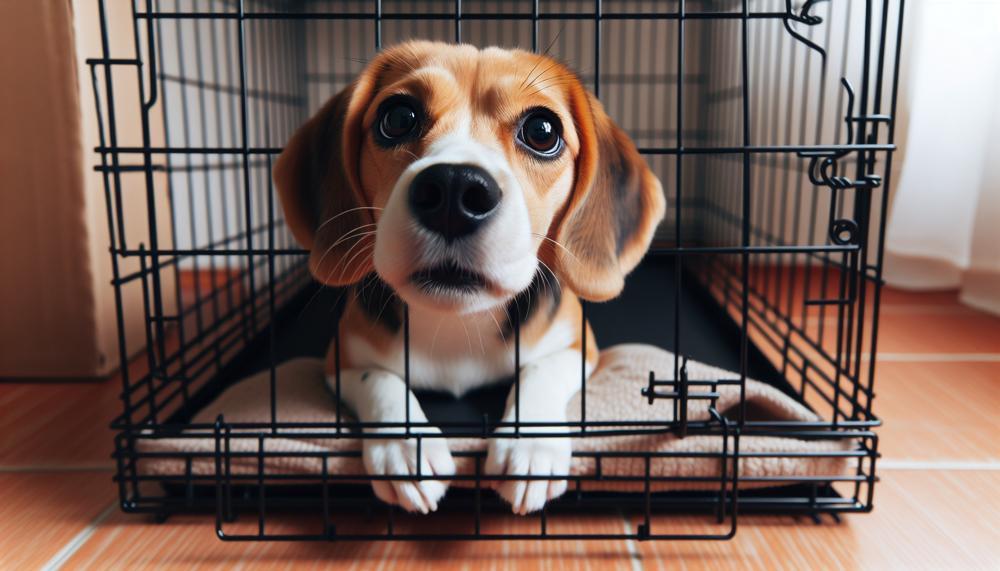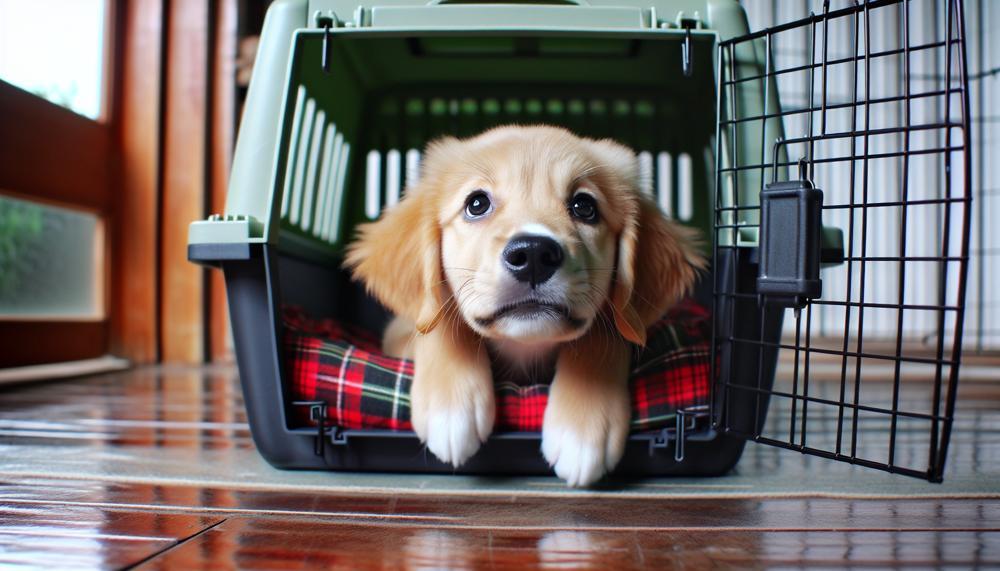Imagine this: you finally arrive home after a grueling day at work, eagerly anticipating the warm welcome from your beloved canine companion. But instead of a tail-wagging and joyful bark, all you hear is a persistent whine coming from your dog’s crate.
What could have triggered this sudden change in behavior? As a devoted dog owner, it can be both concerning and frustrating to deal with a whining dog in their crate.
In this blog post, we will explore the possible reasons behind this behavior and offer practical tips on how to address it.
Here are some key points that we will discuss in detail:
- Dogs may whine in crates due to separation anxiety or boredom.
- It is crucial to identify the underlying cause of the whining before attempting to remedy it.
- Proper crate training techniques can help prevent or minimize whining behavior.
- Providing mental and physical stimulation for your furry friend can also alleviate whining in crates.
- Seeking professional guidance may be necessary if the whining persists.
Now let’s delve into each of these points and gain a deeper understanding of why dogs may suddenly start whining in their crates.
Why is my dog whining in his crate all of a sudden?
Table of Contents
There are many potential reasons why a canine might suddenly start whimpering in their crate. These include anxiety, health concerns, boredom, or outgrowing the crate. It is crucial to identify the root of the problem and come up with a solution to address this behavior.
Possible causes for a whining dog in their crate:
- Anxiety or fear: Dogs may experience feelings of unease or fright when placed in a crate, particularly if they are not accustomed to it. They might associate the crate with negative experiences such as being left alone or disciplined. This can lead to whimpering and other behavioral problems.
- Health issues: Unexpected changes in a dog’s behavior can be an indication of an underlying health problem. It is important to consult with a veterinarian to rule out any potential health issues that may be causing discomfort or pain for the dog.
- Boredom: Canines are social creatures and can quickly become bored when left alone in a confined space like a crate. A lack of stimulation and interaction can result in whimpering and other unwanted behaviors.
- Outgrowing the crate: Just like humans, dogs go through growth spurts and may outgrow their crates. This can cause discomfort and lead them to avoid the crate altogether.
Solutions to address this behavior:
- Consult with a vet: If you notice your dog suddenly whimpering in their crate, it’s best to consult with a veterinarian first to rule out any potential health concerns. Medication or treatment may be necessary in some cases.
- Make adjustments to the crate: Relocating the crate to a more soothing and quiet area, adding toys inside, or using calming scents can help reduce anxiety and boredom for the dog.
- Adjust the size of the crate: If your canine has outgrown their current crate, consider purchasing a larger one or making necessary adjustments to provide more space for them.
- Observe behavior outside of the crate: Pay attention to how your dog behaves outside of the crate. This can offer insight into why they might be whimpering and help find a solution.
- Seek professional help: If the behavior persists, consider seeking assistance from a professional dog trainer or behaviorist who can evaluate the situation and provide guidance on how to address it.
11 reasons why your dog suddenly whines in his crate
Dogs are complex creatures, and there are numerous reasons why your furry friend may suddenly whine in their crate. As a responsible owner, it’s important to address these behaviors and provide your dog with the necessary comfort and care. Below are 11 possible reasons for this behavior and how you can tackle them.
- Boredom: Dogs are highly social and need mental and physical stimulation to thrive. If they don’t get enough exercise or playtime, they may resort to whining in their crate. To prevent this, ensure that your dog is getting enough activity and consider using puzzle toys or interactive games to keep them entertained.
- Fear of confinement: Some dogs may have a fear of being confined, which can lead to whining in their crate. This could be due to past negative experiences or a lack of proper crate training. To address this, make the crate more inviting by adding comfortable bedding and treats, and gradually introduce your dog to the crate by leaving the door open and slowly increasing the amount of time they spend inside.
- Changes in routine or environment: Dogs thrive on routine, so sudden changes in their daily schedule or environment can cause them to feel anxious and whine in their crate. To avoid this, try to maintain a consistent routine for your dog and provide them with a safe and cozy space in their crate.
- Illness or discomfort: Whining in the crate can also be a sign of illness or discomfort. If your dog has suddenly started whining in their crate, consult a veterinarian to rule out any potential health issues.
- Outgrowing the crate: Just like humans, dogs grow and their needs change over time. If your dog’s crate is too small for them, they may become uncomfortable and whine. Consider getting a larger crate to accommodate your growing pup.
- Separation anxiety: Some dogs may develop separation anxiety, which can manifest in behaviors like whining, pacing, and destructive chewing. If your dog only whines in the crate when left alone, it could be a sign of separation anxiety. Seek professional help and gradually desensitize your dog to being left alone.
- Need to go to the bathroom: If your dog suddenly starts whimpering in their crate, it could mean they need to go to the bathroom. Make sure to take them out for regular potty breaks and avoid leaving them in the crate for extended periods of time.
- Attention-seeking: Dogs are social animals and may whine in their crate to get attention from their owners. While it’s important to give your dog love and affection, it’s also crucial not to reinforce this behavior by giving them attention when they whine.
- Hunger or thirst: If your dog hasn’t been fed or given water before being placed in the crate, they may whine due to hunger or thirst.
Should I ignore my dog while he’s whining in his crate?
When your canine companion suddenly starts to whine in their crate, it’s crucial to address the behavior instead of ignoring it. While some dogs may whine as a way to seek attention, sudden whining can also be a sign of discomfort or a need for something.
By addressing the behavior, you can identify the root cause and make any necessary changes to ensure your dog is content and comfortable in their crate.
Addressing the behavior involves identifying the potential reasons for sudden whining and taking appropriate action. This can include taking your dog outside for a potty break if they are signaling a need to go, checking for any signs of illness or discomfort, or simply providing some attention or comfort if they are feeling anxious or scared.
To help you better understand how to respond when your dog suddenly starts whining in their crate, let’s explore some common reasons for this behavior:
Reasons why dogs whine in crates:
Potty needs
Your furry friend may be signaling that they need to relieve themselves. Take them outside and give them an opportunity to do so.
Illness/injury
Whining can be an indication of pain or discomfort, so check your dog for any signs of illness or injury.
If you suspect something is wrong, take them to the vet for a check-up.
Discomfort
Your dog may feel uncomfortable in their crate due to the temperature, lack of space, or other factors.
Ensure their crate is cozy and suitable for their size.
Attention/items
Some dogs may whine in their crate as a way to get attention or access to items they want.
Resist giving in to their demands and instead provide positive reinforcement when they are quiet.
Incomplete training
If your dog is still learning to adjust to their crate, they may whine as they try to get out.
Be patient and consistent with training to help reduce whining over time.
Spontaneous recovery
Puppies may experience spontaneous recovery during crate training, but this will pass with consistency.
Be patient and provide positive reinforcement when they are quiet.
Outgrowing the crate
If your dog has outgrown their crate, they may feel cramped and uncomfortable, leading to whining.
Consider getting a larger crate or allowing them more space in their current one.
Separation anxiety
Some dogs may whine in their crate due to separation anxiety.
Gradually acclimating them to being alone and providing comfort while they are in the crate can help alleviate this issue.
Need for attention
Some dogs may whine in their crate because they want attention from their owners.
Ensure to give them plenty of love and attention outside of the crate to prevent this behavior.
Hunger/thirst
If your dog is hungry or thirsty, they may whine in their crate.
Make sure to provide them with an adequate amount of food and water before crating them.
How do I get my dog to like his crate again? 5 tips
| 5 Tips for Reintroducing Your Dog to Their Crate | Why These Tips Work | Demonstrative Examples |
| Start Fresh with a Different Crate | Past negative associations with their current crate may be causing anxiety or discomfort for your dog. | If your dog has had a bad experience in their current crate, switching to a new one can help reset their associations and create a more positive and inviting space. |
| Upgrade to a Larger Crate | Your dog may have outgrown their current crate, leading to feelings of confinement and discomfort. | If your dog is too big for their current crate, upgrading to a larger size can give them more room and make them feel less restricted. |
| Avoid Forcing or Rushing | Pushing or pulling your dog into or out of the crate can create negative associations and lead to resistance. | Allow your dog to enter and exit the crate at their own pace, and never force them inside before they are ready. |
| Create a Cozy Environment | A comfortable and familiar setting can help your dog feel more at ease in their crate. | Add a soft cushion or blanket, as well as familiar toys and treats, to make the crate a warm and inviting space for your dog. |
| Associate with Positive Experiences | Gradually introducing positive experiences with the crate can help your dog learn to enjoy it once again. | Start by feeding meals inside the crate with the door open, then gradually close the door while they eat. Use food toys and slowly increase the time with the door closed to build positive associations. |
If your dog continues to show signs of anxiety or discomfort in their crate, it may be necessary to seek professional help from a trainer or behaviorist. It’s important to work within your dog’s comfort level and use patience and positive reinforcement to help them learn to enjoy their crate again.

Conclusion
In conclusion, a dog’s sudden whining in their crate can be a cause of concern and frustration for any dedicated pet owner. It is important to address this behavior promptly and effectively to ensure the well-being of your furry friend.
We delved into the possible reasons behind this sudden whining, including separation anxiety, boredom, and outgrowing the crate. We also provided practical tips on how to tackle this behavior, such as using proper crate training techniques and providing mental and physical stimulation for your dog.
Identifying the root cause of the whining is crucial before attempting to remedy it. This may involve seeking professional guidance or making adjustments to the crate or environment. By addressing the behavior and giving necessary care and attention, pet owners can help their dogs learn to enjoy their crates once again.
It is essential to remember that every dog is unique, and what works for one may not work for another. Patience, consistency, and attentiveness are key when dealing with a whining dog in their crate. With love and proper training, you can assist your furry companion in overcoming this behavior and creating a positive association with their crate.






